30 Red Flowering Trees (with Pictures): Identification Guide
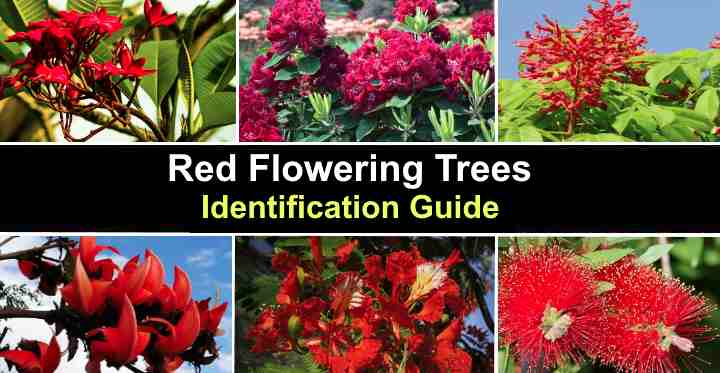
Red flowering trees are a stunning addition to any garden landscape. Trees with red flowers add a burst of vibrant crimson, burgundy, maroon, and ruby-red shades. Red-flowering trees come in all shapes and sizes. Whether you’re looking for a small ornamental tree or a larger shade tree, there are plenty of options to choose from.
The best red-flowering trees for ornamental value are dogwood, Chinese hibiscus, magnolia, and red frangipani trees. Large trees with red flowers like the red buckeye, horse chestnut, and red maple trees are perfect shade trees in wide landscapes.
This article is an identification guide to stunning red-flowering trees. Descriptions and pictures of various tree species with red blooms will help you recognize and choose the best trees to add vibrant color to your landscape.
Red Flowering Trees (With Pictures): Identification Guide
Crape Myrtle (Lagerstroemia)
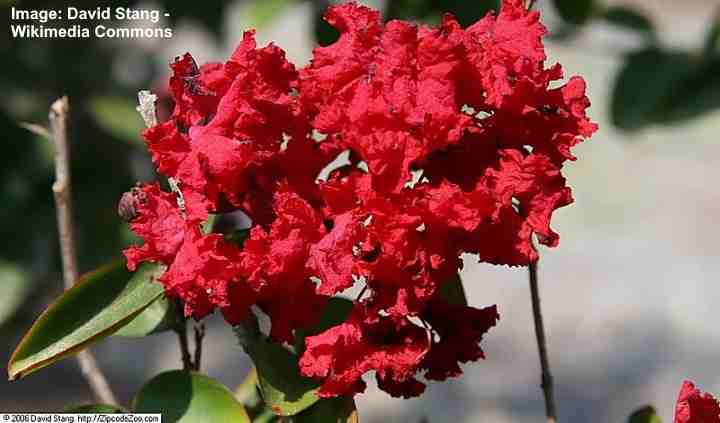
Lagerstroemia indica ‘Dynamite’
The crape myrtle is a fast-growing flowering tree in various colors, including vibrant red shades. The tree is known for its large clusters of crinkled flowers that bloom throughout summer. When in bloom, the shrub-like tree is covered in masses of cherry-red flowers, making a stunning statement in any landscape.
The foliage on crape myrtle trees emerges crimson red in spring and matures to dark green before turning eye-catching red and orange shades in the fall. The tree’s smooth and mottled bark provides additional visual interest in late fall and winter.
Landscaping uses for red-flowering, easy-care crape myrtles include specimen trees, border plants, or foundation plantings. The versatile trees are adaptable to a wide range of soil types and can tolerate heat and drought.
With their long bloom period and low maintenance requirements, crape myrtles are a popular choice for gardens and landscapes.
Here are a few spectacular examples of red-flowering crape myrtle trees:
Lagerstroemia ‘Red Rocket’: The tree is characterized by large cherry red-flower clusters 24” (60 cm) long.
Lagerstroemia ‘Dynamite’: This stunning deciduous tree has true ted blossoms growing in large conical clusters 14” (35 cm) long.
Lagerstroemia ‘Tonto’: This small shrub-like tree has large, bright magenta-red flowers and reddish-purple fall foliage. The red-flowering clusters measure 6” (15 cm) long.
Mature Size: Range from 8 to 30 ft. (2.4 – 9 m) tall and up to 20 ft. (6 m) wide, depending on the variety.
USDA Hardiness Zones: 6 to 9
Sun: Full sun to partial shade
Red Horse Chestnut (Aesculus carnea)
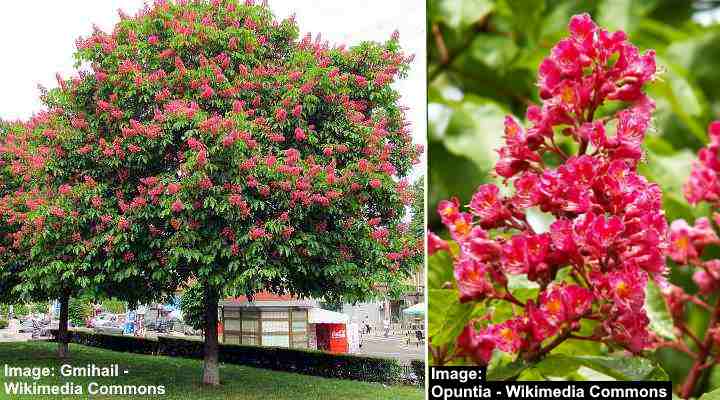
The flowering red horse chestnut is a striking tree that can be identified by its showy cone-shaped clusters of bright red flowers and large, palmate leaves. The erect conical clusters bloom in late spring, creating a spectacular pinkish-red floral display. The five-petaled flowers contrast beautifully with the tree’s dark green foliage.
Red horse chestnut trees are identified by their large, palmate leaves, which is also a standout feature. The leaves have a coarse texture but don’t produce any significant fall colors. The red horse chestnut is a fast-growing tree with a rounded shape, making it a great choice for shade or as a focal point in a garden or landscape.
Red horse chestnuts thrive in well-drained soil and can tolerate various soil types. They are also relatively low maintenance and can withstand drought conditions once established. Additionally, they are less susceptible to disease than other horse chestnut trees, making them easy to maintain.
Mature Size: 30 to 40 ft. (9 – 12 m) tall and wide
USDA Hardiness Zones: 5 to 8
Sun: Full sun to partial shade
Red Buckeye (Aesculus pavia)
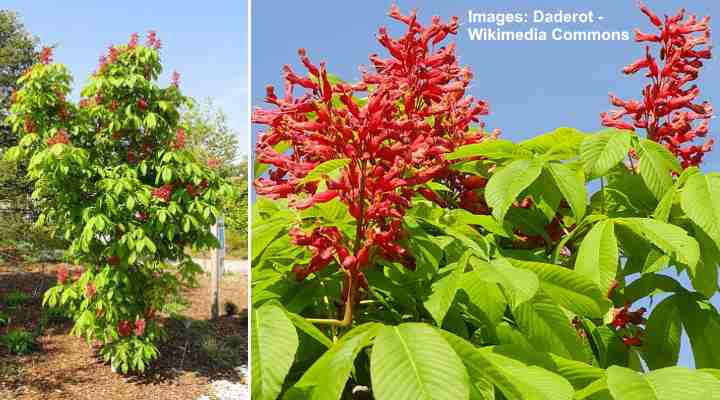
The red buckeye is a small tree known for its striking red flowers. Clusters of tubular-shaped flowers bloom in spring at the end of woody stems. The rich red flowers attract hummingbirds and butterflies. The red buckeye’s flowers are followed by dark brown, shiny seeds that are toxic if ingested.
The red buckeye has palmate leaves with five lance-shaped drooping leaflets that provide a nice backdrop to the vibrant flowers. The tree’s fall foliage color is yellow but doesn’t stand out in an autumn landscape. The red buckeye tree is a great addition to woodland gardens, native gardens, or as a specimen tree in a smaller landscape.
Native to North America, Red buckeyes prefer well-drained, moist soil and can tolerate a variety of soil types. They also prefer partial shade in hot summer climates but can tolerate full sun with adequate moisture.
Mature Size: 12 to 15 ft. (3.6 – 4.5 m) tall and wide
USDA Hardiness Zones: 5 to 9
Sun: Partial shade to full sun
Red Flowering Magnolia Trees
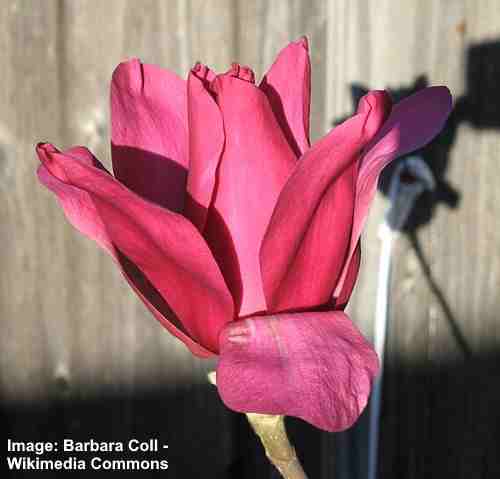
Magnolia ‘Vulcan’
Red-flowering magnolia trees are known for their stunning red blooms that add a splash of color to any landscape. The deciduous trees produce large, cup-shaped flowers in rich, ruby-red shades. Each individual flower has 12 curved petals creating a cup shape measuring 12” (30 cm) across.
Red-flowering magnolia trees also have large obovate leaves creating attractive mid-green foliage. Ornamental magnolia trees are generally low maintenance and can tolerate various soil types, although they prefer well-drained soil.
Small magnolia trees for tropical landscapes bloom in shades of yellow, white, and pink. Here are two stunning examples of red-flowering magnolias:
Magnolia ‘Vulcan’: The large cup-and-saucer-shaped blossoms emerge deep pink but become redder as they mature.
Magnolia’ Red As’ / ’ Red As Red’: The small tree is characterized by goblet-shaped dark purple-red flowers. Its mature size is 10 ft. (3 m) high and 6.5 ft. (2 m) wide.
Mature Size: 10 to 15 ft. (3.6 – 4.5 m) tall and 8 to 10 ft. (2.4 – 3 m) wide
USDA Hardiness Zones: 5 to 9
Sun: Full sun to light shade
Crimson Bottlebrush Tree (Melaleuca citrina)
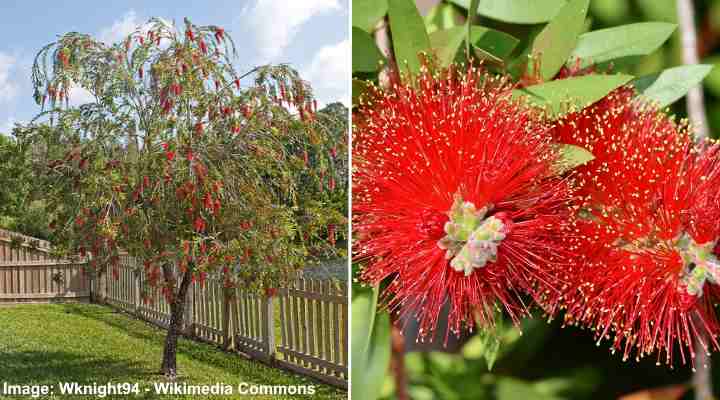
The crimson bottlebrush tree is a small evergreen tree with shrubby growth known for its unique bottlebrush-shaped flowers. The long fuzzy conical flowers are bright red and resemble a conical brush for cleaning bottles. Also called the lemon bottle brush, the tree’s leaves have a citrusy fragrance when crushed.
Bottlebrush trees produce narrow, lance-shaped leaves that are dark green and glossy. The lanceolate leaves turn coppery-brown in the fall. After flowering, woody, cup-shaped seed capsules appear and remain on the plant through winter. The glossy green foliage contrasts nicely with the bright crimson flowers.
The crimson bottlebrush tree is a sun-loving, drought-tolerant tree and prefers well-drained soil. Landscaping uses for the red-flowering tree include an ornamental shrub, flowering hedge, or foundation planting. Its tolerance to salty air makes it ideal for coastal gardens.
Mature Size: 8 to 15 ft. (2.4 – 4.5 m) tall and wide
USDA Hardiness Zones: 8 to 11
Sun: Full sun, six hours of direct sunlight or more
Tree Rhododendron (Rhododendron arboreum)
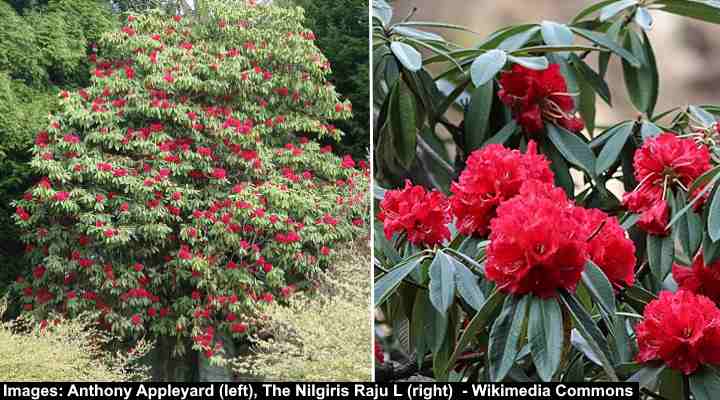
The tree rhododendron is a large, evergreen shrub that can be trained to grow as a small red-flowering tree. The rhododendron tree is known for its large clusters of beautiful bright red to scarlet red, summer-blooming flowers. The flowers are trumpet-shaped with wavy petals and emit a sweet fragrance.
The tree rhododendron’s leaves are dark green and leathery in a lanceolate shape. In the fall, the leaves may turn bronze or reddish-purple before dropping.
This majestic rhododendron is best suited for larger landscapes as a specimen or shade tree. It prefers well-drained, acidic soil and partial shade. The tree rhododendron is cold-hardy and can withstand colder climates.
Mature Size: 20 to 40 ft. (6 – 12 m) tall and wide
USDA Hardiness Zones: 7 to 9
Sun: Full sun to partial shade
Red Frangipani Tree (Plumeria Rubra)
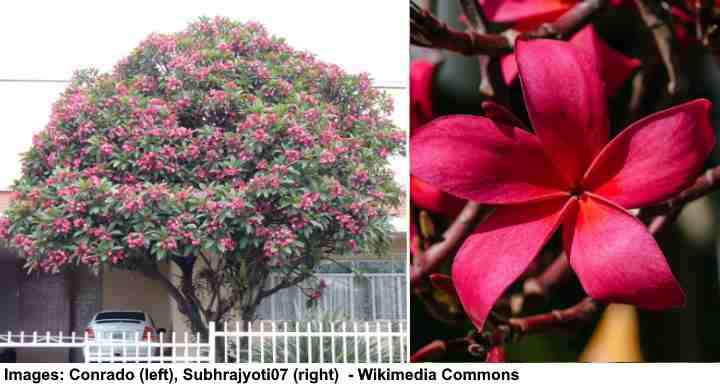
The red frangipani is a tropical tree known for its stunning red exotic flowers. The large star-shaped flowers are bright magenta-red and emit a sweet fragrance. The tree’s lush foliage, deep pink or red flowers, and long cylindrical seed pods make the ornamental tree popular in tropical gardens and landscapes.
The red frangipani blooms throughout the year, brightening any outdoor space. The red flowers contrast beautifully with the thick, fleshy, dark green leaves. The red frangipani is a small to medium-sized tree, making it suitable for gardens of all sizes.
The red frangipani is native to tropical regions and thrives in hot and humid climates. The heat-loving tree performs well in beds and borders, growing as a patio tree or in a container. The frangipani tree thrives in medium-moist, well-drained soils.
Mature Size: 15 to 25 ft. (4.5 – 7.5 m) tall and wide
USDA Hardiness Zones: 10 to 12
Sun: Full sun
Chinese Hibiscus Tree With Red Flowers (Hibiscus rosa-sinensis)
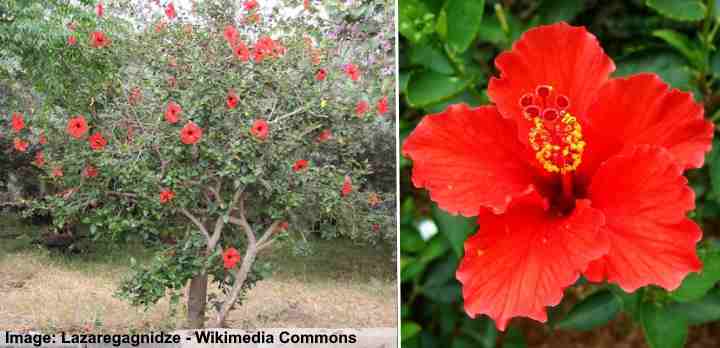
The Chinese hibiscus is a tropical evergreen tree that produces large, showy trumpet-like red flowers. The hibiscus flowers are known for their floral fragrance, papery petals, and protruding stamen from the funnel-like blooms. The five-petaled flowers can measure up to 4” (10 cm) in diameter.
The red hibiscus flowers are vibrant and eye-catching, making them popular for tropical gardens. In addition to the red showy flowers, the Chinese hibiscus has glossy, dark green lance-shaped leaves. This ornamental tree is evergreen in tropical climates but may lose its leaves in colder regions.
Chinese hibiscus plants prefer well-drained soil and full sun to partial shade. In tropical regions, they require regular watering, especially during dry periods. Ornamental uses in gardens include growing as an ornamental shrub, using for a privacy hedge or screen, or attracting pollinators. In cooler climates, you can grow it in containers to overwinter indoors.
Mature Size: 8 to 16 ft. (2.5 – 4.9 m) tall and 5 to 10 ft. (1.5 – 3 m) wide
USDA Hardiness Zones: 10 to 12
Sun: Full sun to partial shade
Royal Poinciana Tree (Delonix regia)
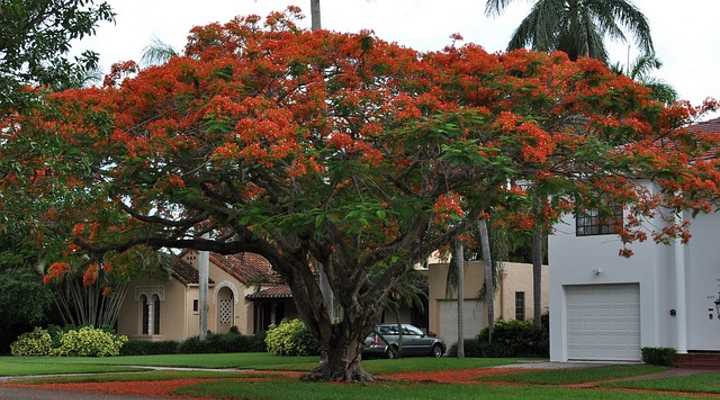
Known as the flamboyant tree, the royal poinciana tree blooms with stunning scarlet-orange flowers on an umbrella-like canopy. The spectacular colorful flowers measure up to 4” (10 cm) across and create a breathtaking floral display. After flowering, the brilliantly-colored blossoms give way to bean-like seed pods.
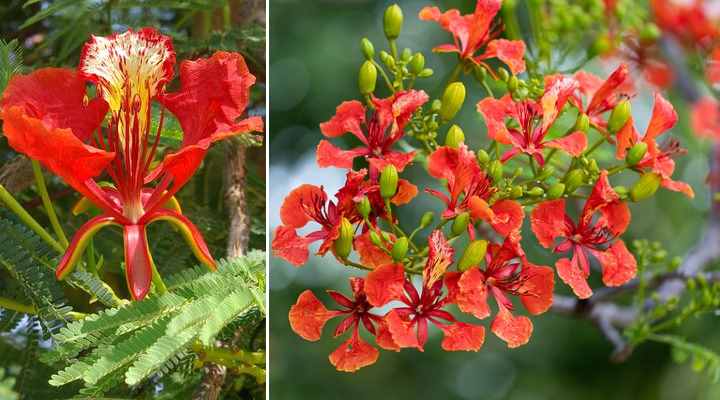
A close up pictures of royal poinciana flowers
In addition to its beautiful flowers, the royal poinciana tree has fern-like, feathery foliage that adds to its visual appeal. The evergreen leaves, long-blooming red flowers, and ornamental seed pods give the tropical tree four-season interest.
The royal poinciana tree is a popular choice for landscaping due to its stunning flowers and attractive foliage. You can grow the tree as a shade, lawn, or street tree. The tree is relatively low maintenance and can tolerate a variety of soil types, although it prefers well-drained soil.
Mature Size: 30 to 40 ft. (9 – 12 m) tall and 40 to 70 ft. (12 – 21 m) wide
USDA Hardiness Zones: 10 to 12
Sun: Full sun
Red Flowering Dogwood Tree (Cornus florida ‘Cherokee Chief’)

The red-flowering dogwood tree is a beautiful ornamental tree with vibrant red flowers suitable for small gardens. In spring, the tree’s bare branches are covered in flowers consisting of five red, petal-like bracts surrounding a cluster of tiny green flowers. The red flowers give way to shiny berry clusters that persist until fall.
The red-flowering dogwood has a stunning rounded canopy of ovate green leaves. These grow on tiered or horizontal branches, giving the tree an interesting silhouette. The tree’s foliage turns attractive scarlet and purple shades in the fall. Its four-season visual interest comes from its unusual alligator-skin-like bark visible in late fall and winter.
The red-flowering dogwood is perfect for small gardens to provide shade near a lawn or patio. It also works as a border or screen tree when planted in acidic to neutral, well-drained, moist soil.
Mature Size: 20 to 25 ft. (4.5 – 9 m) tall and 12 to 18 (3.6 – 5.4 m) wide
USDA Hardiness Zones: 5 to 9
Sun: Full sun to partial shade
Crabapple (Malus prairifire)
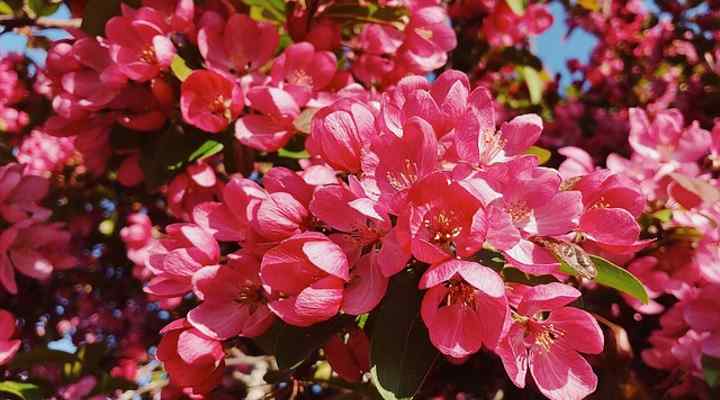
The ‘Prairifire’ crabapple is a small fruiting tree known for its beautiful dark pink to red flowers. The crabapple flowers bloom in dense clusters, covering the upright rounded canopy in mid to late spring. The tree’s vibrant red shades add beauty to any landscape. After flowering, small cherry-like apples appear.
‘Prairifire’ crabapple trees produce dark green leaves with recognizable purplish-red veins. The dense foliage turns a spectacular golden-bronze in the fall, brightening autumn landscapes. It also has attractive glossy dark red bark with distinctive lenticels.
Prairifire crabapple trees are popular in small gardens for their ornamental value. They perform well in moderately fertile soil with excellent drainage. Their attractive flowers and fruit attract pollinators, birds, and other wildlife, making them a great addition to wildlife gardens.
Mature Size: 15 to 20 ft. (4.5 – 6 m) tall and wide
USDA Hardiness Zones: 4 to 8
Sun: Full sun
Red Silk Cotton Tree (Bombax ceiba)
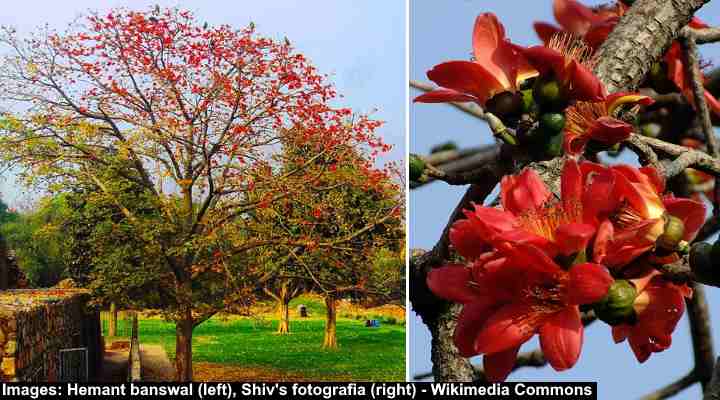
The red silk cotton tree is a heat-loving tropical tree that produces stunning red flowers. Identifying features of the red flowering tree are its smooth gray bark, vibrant red flowers, and palmate green leaves. Additionally, the red silk tree has seeds covered in silky, woolly hairs.
The red silk cotton tree is native to tropical regions and thrives in warm climates. The large tree is ideal for shade in large open spaces and parks. The red silk cotton tree is common in Florida and other southern states.
Mature Size: 60 to 70 ft. (18 – 21 m) tall and 40 to 60 ft. (12 – 18 m) wide
USDA Hardiness Zones: 10 to 12
Sun: Full sun
African Tuliptree (Spathodea campanulata)
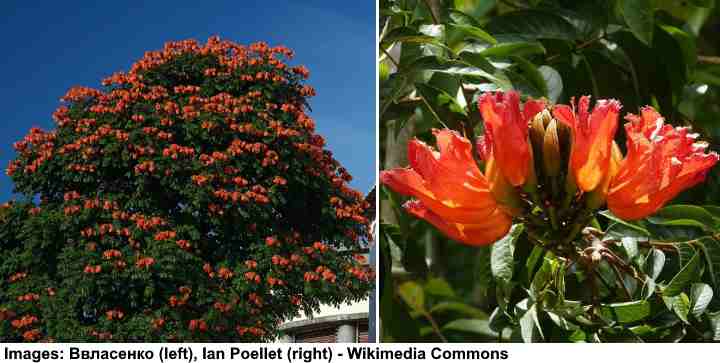
The African tuliptree is a large tree with vibrant reddish-orange cup-shaped flowers. Shaped like tulip flowers, the eye-catching blooms grow in clusters at the ends of the branches, blooming in spring and throughout summer. The flowers attract hummingbirds and butterflies, adding to the tree’s beauty and ecological value.
Leaves on the African tuliptree are large, glossy green blades that provide lush foliage in tropical gardens. The oval-shaped leaves are arranged in an alternate pattern along the branches. In addition to its attractive orange-red flowers and glossy foliage, the African tuliptree has a distinctive trunk with smooth, gray-brown bark.
This tropical tree thrives in warm, humid climates. It prefers moderately fertile, well-drained soil. The African tuliptree is common as a shade tree in city parks and a flowering landscape tree.
Mature Size: 25 to 40 ft. (7.6 – 12 m) tall and 15 to 20 ft. (4.5 – 6 m) wide
USDA Hardiness Zones: 10 to 11
Sun: Full sun
Powderpuff Tree (Calliandra haematocephala)
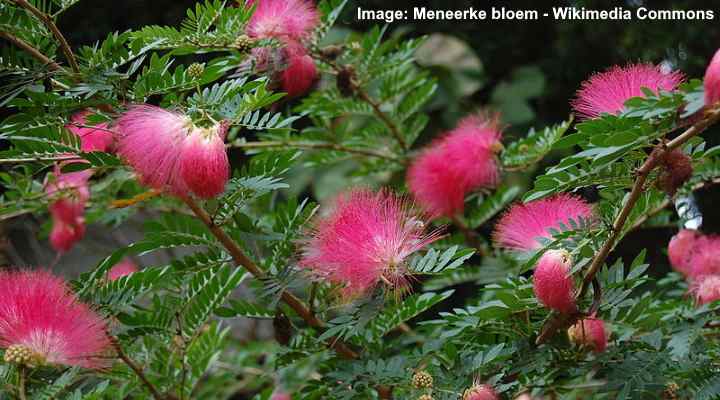
The powderpuff tree is a small tree with distinctive red powderpuff flowerheads. The bright scarlet red flowers contrast with the delicate fern-like leaves. The attractive tree foliage emerges copper-pink and matures to dark green. In tropical landscapes, the vibrant red flowers bloom in fall and winter and sporadically throughout the year.
Powderpuff trees thrive in well-drained, organically rich fertile soil. Once established, the tree tolerates heat and drought and requires minimal pruning. The powderpuff tree will make a statement in any landscape with its striking scarlet flowers and feathery foliage.
Mature Size: 3 to 6 ft. (1 – 1.8 m) tall and wide
USDA Hardiness Zones: 9 to 11
Sun: Full sun
Red Bird of Paradise (Caesalpinia pulcherrima)
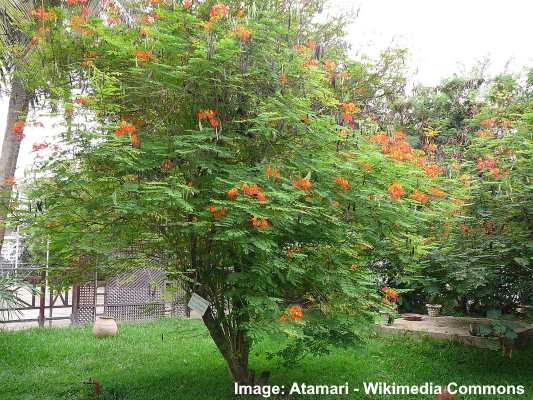
Also known as the peacock flower, the red bird of paradise is a tropical shrub or small tree prized for its stunning red and orange flowers. The red blooms consist of bowl-shaped five-petaled flowers that bloom on prickly stems from spring through fall. The stunning flowers resemble flowers on the royal Poinciana (Delonix regia) tree, hence its other common name—dwarf poinciana.

Flowers of red bird of paradise
The red bird of paradise ornamental tree has fern-like, compound leaves and spiny branches. This drought-tolerant tree thrives in hot and dry climates, making it a popular choice for desert gardens or xeriscape landscapes. It also performs well as a specimen tree in a garden or as a border plant.
The red bird of paradise tree is a great choice for adding color and tropical flair to your tight or compact outdoor space.
Mature Size: 10 to 20 ft. (3 – 6 m) tall and 6 to 12 ft. (1.8 – 3.6 m) wide
USDA Hardiness Zones: 9 to 11
Sun: Full sun
Red Flowering Gum Tree (Corymbia ficifolia)
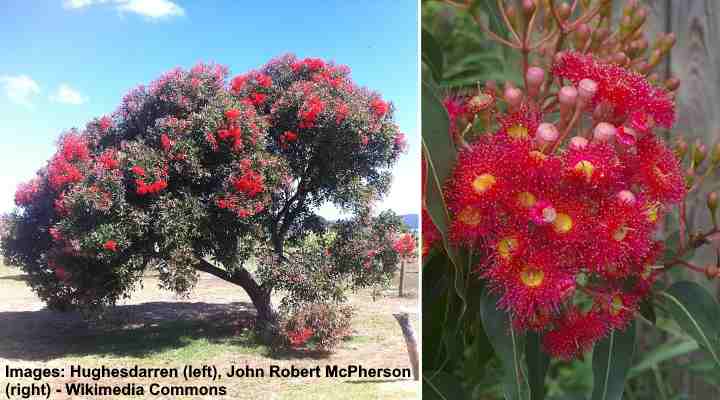
The red-flowering gum tree is a stunning red-flowering tree known for its bright clusters of large, showy flowers. The fast-growing evergreen tree blooms in shades ranging from bright red to pink or orange. The flowers attract nectar-feeding birds and bees, making it a popular choice for wildlife gardens.
The red-flowering gum tree has glossy, dark green leaves with a prominent yellow midrib. After the flowers fade, urn-shaped fruits appear on the tree. The drought-tolerant tree performs well in hot, dry landscapes as a specimen or shade tree. It also grows well in coastal gardens thanks to its salt air tolerance.
Mature Size: 20 to 40 ft. (6 – 12 m) tall and 15 to 60 ft. (4.54 – 18 m) wide
USDA Hardiness Zones: 9 to 11
Sun: Full sun to partial shade
Pomegranate Tree (Punica granatum)
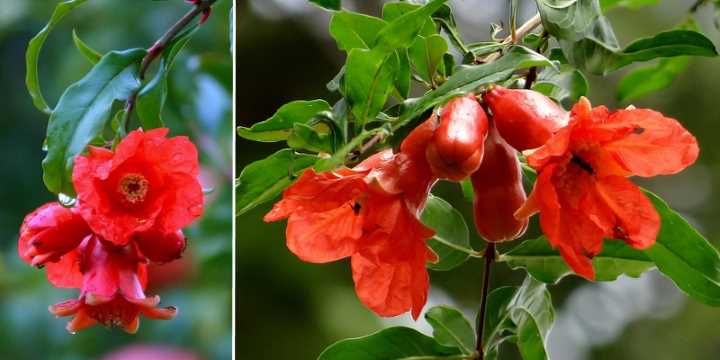
Pomegranate flowers
The pomegranate tree is a small deciduous tree known for its vibrant red flowers and delicious fruit. The tree’s bright scarlet flowers are cup-shaped and consist of papery crinkled petals with a cluster of yellow-tipped stamens in the center. The flowers are followed by round, juicy pomegranate fruits filled with sweet-tart arils.
Pomegranate trees are identified by their multi-stemmed habit, evergreen, narrowly oblong leaves, and summer-long blooms. The leaves turn yellow in the fall, adding to the tree’s seasonal interest. Pomegranate trees are popular in Mediterranean-style gardens and in containers on patios or balconies.
Mature Size: 6 to 20 ft. (1.8 – 6 m) tall and 4 to 5 ft. (1.2 – 4.5 m) wide
USDA Hardiness Zones: 8 to 11
Sun: Full sun
Red Silky Oak Tree (Alloxylon flammeum)

The red silky oak tree is a striking medium-sized red-flowering tree for tropical landscapes. The decorative tree is known for its vibrant red tubular flowers growing in clusters. The upward-pointing flowers create a stunning spring floral display contrasting with the slender lance-shaped leaves. In fall, woody seed pods appear and ripen by spring.
The red silky oak tree is best suited as a specimen tree in large gardens, parks, and open landscapes. Its broad canopy and dense foliage make it ideal for growing beside patios or decking areas as a shade tree.
Mature Size: 30 to 50 ft. (9 – 15 m) tall and 20 to 30 ft. (6 – 9 m) wide
USDA Hardiness Zones: 9 to 11
Sun: Full sun to partial shade
Indian Coral Tree (Erythrina variegata)
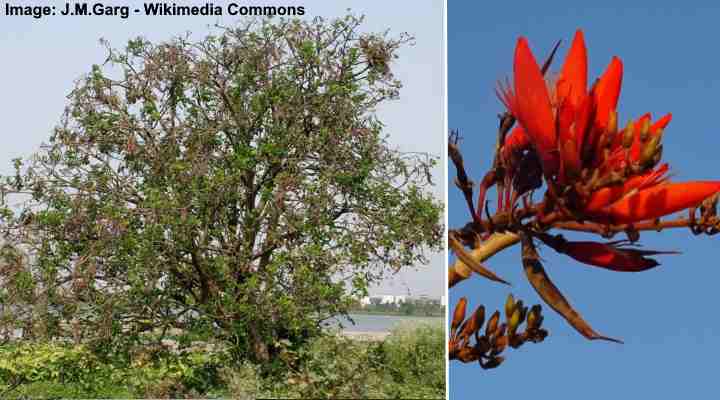
The Indian coral tree is a deciduous ornamental tree known for its striking crimson or scarlet flowers. The tree produces clusters of bright red blossoms that resemble coral, hence its name. The vibrant flowers attract birds, pollinators, and butterflies, making it a popular choice for wildlife gardens in tropical and subtropical regions.
The Indian coral tree has large, compound leaves, each with three leaflets measuring 2” to 4” (5 – 10 cm). The foliage is typically green, but some varieties may have variegated or mottled leaves. The lush green foliage contrasts with the red, orange, and occasionally pink flowers.
This tree thrives in warm climates and prefers well-drained soil. It’s useful as a shade tree in large gardens, parks, or open spaces. The vibrant flowers make it a desirable choice for adding color to the landscape, and its spreading canopy provides relief from the sun.
Mature Size: 20 to 40 ft. (6 – 12 m) tall and wide
USDA Hardiness Zones: 10 and 11
Sun: Full sun
‘Hardy Red’ Oleander (Nerium oleander ‘Hardy Red’)
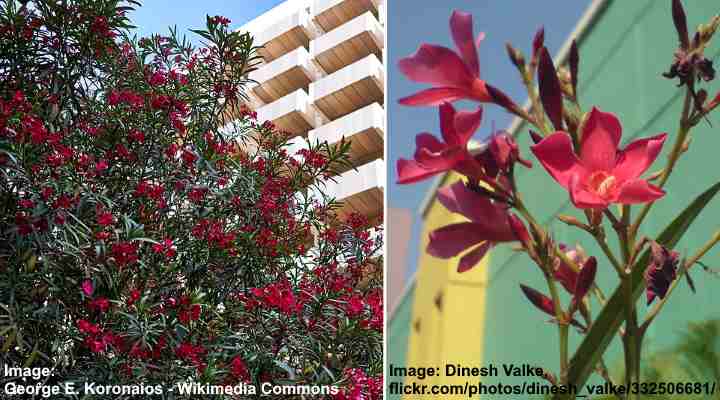
The ‘Hardy Red’ oleander is a stunning flowering shrub or small tree with deep red flowers. The vibrant red funnel-shaped blooms add a splash of color to summer landscapes. The five-petaled deep red flowers bloom in clusters from spring to fall. The ‘Hardy Red’ cultivar is known for its ability to withstand colder temperatures than other oleander varieties.
The ‘Hardy Red’ oleander has long, dark green lanceolate leaves growing on a vase-shaped canopy. The multi-stemmed shrub or small tree grows well as a red-flowering hedge, evergreen privacy screen, or specimen plant. It is also drought-tolerant and low-maintenance, making it a popular choice for gardens in hot and dry regions.
However, it is important to note that all parts of the oleander are toxic if ingested. Therefore, you should be careful planting in gardens where children and pets play.
Mature Size: 6 to 15 ft. (1.8 – 3.6 m) tall and up to 10 ft. (3 m) wide
USDA Hardiness Zones: 7 to 12
Sun: Full sun
Flame of the Forest Tree (Butea monosperma)
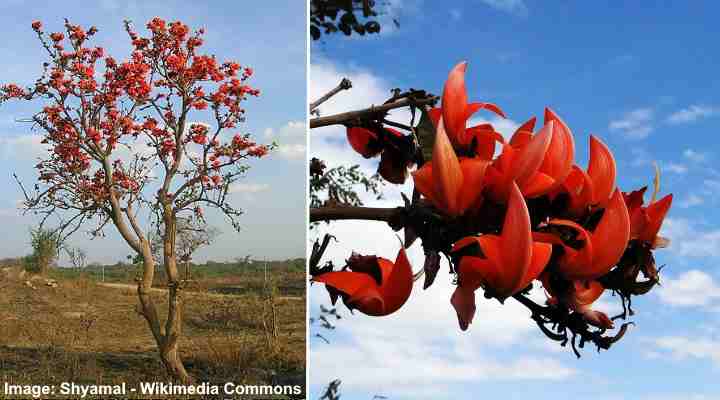
The flame of the forest tree creates a stunning floral display of brilliant orange-red flowers. The small to medium-sized tree has a wide, spreading canopy covered in vibrant red blossoms in late winter and early spring. After the flowers fade, flat single-seeded bronze-brown pods appear. Its attractive shape, lush foliage, and bright flowers give the tree tremendous visual appeal.
Flame of the forest trees are popular shade trees in parks and gardens. The trees adapt to a range of soils but prefer organically rich, well-drained fertile soils. They can tolerate both drought and flooding conditions.
Mature Size: 30 to 40 ft. (9 – 12 m) tall and wide
USDA Hardiness Zones: 10 to 12
Sun: Full sun to partial shade
Red Angel’s Trumpet Tree (Brugmansia sanguinea)
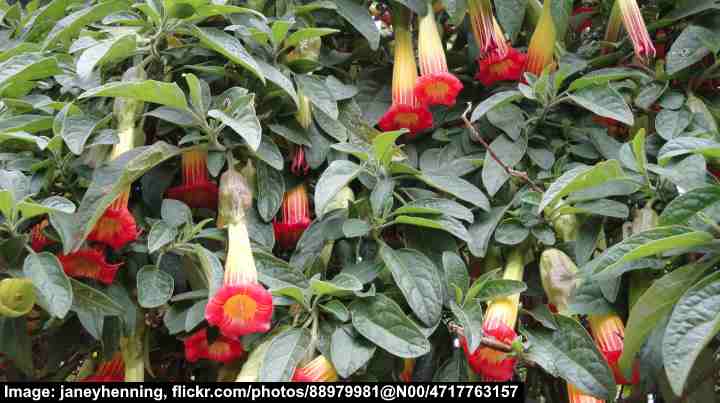
One of the most spectacular red-flowering trees is the red angel’s trumpet tree. This small red flowering tropical tree can be identified by its large, pendulous funnel-shaped flowers. The multi-colored flowers are green and yellow with brilliant red mouths. The exotic, colorful fragrance flowers attract hummingbirds and butterflies.
The red angel’s trumpet tree is a fast-growing ornamental tree with four-season interest. It’s a bushy tree with a spreading habit, tropical flowers, and lush green foliage.
Due to its tropical nature, the red angel’s trumpet tree is best suited for warmer climates. You can grow it in gardens, as a border shrub, or in containers for patios and decks.
However, it should be noted that all parts of the tree are toxic if ingested. Therefore, it may not be suitable for planting in backyards where children and pets play.
Mature Size: 8 to 12 ft. (2.4 – 3.6 m) tall and 6 to 8 ft. (1.8 – 2.4 m) wide
USDA Hardiness Zones: 9 to 11
Sun: Full sun to partial shade
Red Flowering Grevillea Trees
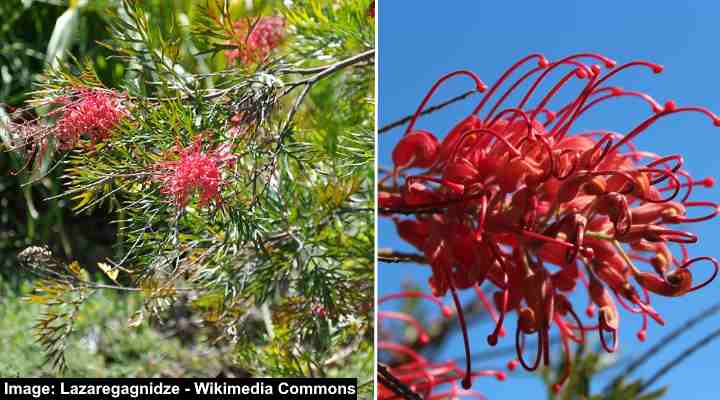
Red flowering grevillea is a small tree known for its stunning red flowers that bloom year-round. This bushy plant has large cylindrical clusters of spidery red flowers. The unique flowers have curled petals and showy arching stamens, giving the flowers an exotic appearance. The red flowers attract birds and bees, making them a great addition to any garden or landscape.
Grevillea trees have slender fern-like leaves that are typically dark green or silver-gray. They are drought-tolerant and are ideal for planting in xeriscape gardens, coastal landscapes, and arid conditions. Grevillea trees perform well as a hedge, screen, specimen plant, or windbreak.
Mature Size: 4 to 8 ft. (1.2 – 2.4 m) tall, depending on the species
USDA Hardiness Zones: 9 to 11
Sun: Full sun to partial shade
Waratah (Telopea)
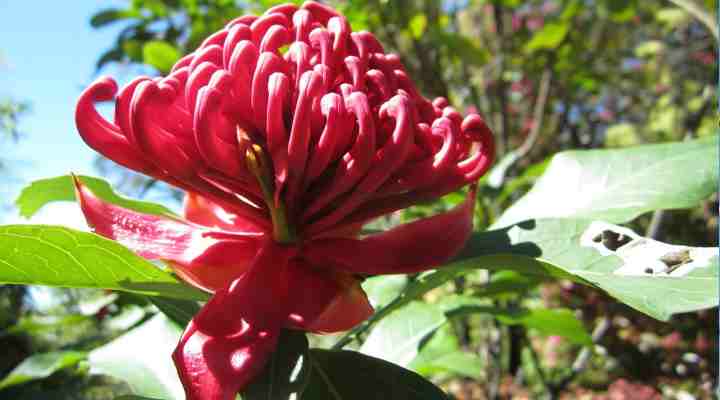
The waratah is a striking flowering tree known for its large, vibrant red or pink rounded flower clusters. The eye-catching flowers are large, bold, and showy, resembling a traditional waratah flower. They bloom at the end of long stalks. Each flower head is composed of a cluster of florets surrounded by colorful red, maroon, or pink bracts.
The waratah tree produces dark green, leathery, lanceolate leaves with serrated margins. The slow-growing tree has a dense, compact growth habit. You can grow waratah trees or shrubs as focal points in gardens or as a standalone specimen tree. They are also popular in cut flower arrangements due to their unique and eye-catching blooms.
Waratahs prefer well-drained soil and full sun to partial shade. They tolerate a range of soil types and can withstand drought conditions once established. However, they may require some protection from strong winds.
Mature Size: 3 to 10 ft. (1 – 3 m) tall and wide
USDA Hardiness Zones: 8 to 10
Sun: Full sun to partial shade
Common Flowering Quince (Chaenomeles speciosa)
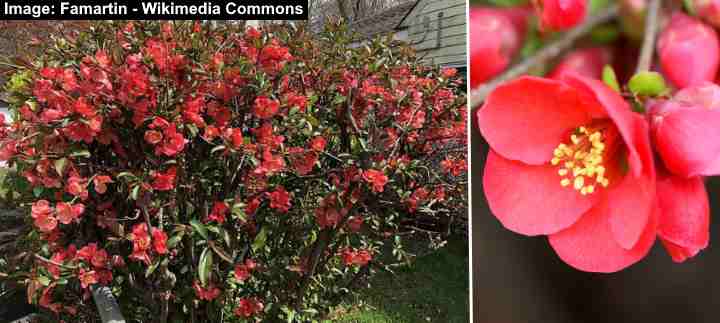
The common flowering quince is a deciduous thorny shrub or small tree that produces beautiful scarlet-red flowers in late winter and early spring. The small, cup-shaped flowers have five stalked petals, appearing before the leaves emerge. The bright red flowers add a burst of color to the landscape and attract pollinators like bees and butterflies.
The common flowering quince has oval-shaped, glossy, dark green leaves. In the fall, the attractive foliage turns red or burgundy shades, adding to the tree’s ornamental value. The small shrub-like tree’s dense, thorny growth makes it an excellent choice for hedges or privacy screens. You can also grow the suckering shrub as a standalone specimen plant or train as a small tree.
Flowering quince shrubs and trees adapt to various soil types—sandy, rocky, clay, and loamy. They are drought-tolerant once established.
In addition to its ornamental qualities, red-flowering quince produces edible apple-shaped pomes. These small sour fruits are yellow with small dots. They are typically used to make quince jelly.
Mature Size: 6 to 10 ft. (1.8 – 3 m) tall and wide
USDA Hardiness Zones: 4 to 9
Sun: Full sun to partial shade
Red Maple (Acer rubrum)
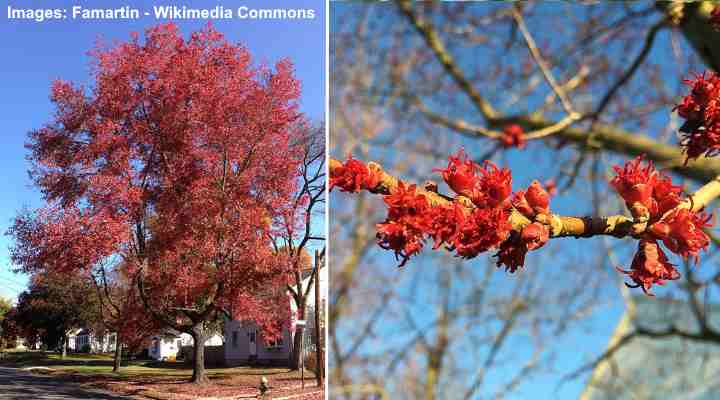
The red maple is a stunning deciduous ornamental tree known for its vibrant red flowers and yellow and red fall colors. Its tiny red flowers grow in small erect clusters on bare branches. Red leaves emerge in late spring and turn green by summer. In the fall, the red maple’s foliage color is eye-catching yellow and red shades.
One of the outstanding ornamental features of the red maple is its reddish-pink winged samaras (seed capsules). Also, its smooth gray bark becomes furrowed with age, adding to the tree’s aesthetic appeal.
Red maples are versatile trees that can be used as shade trees, street trees, or as a focal point in a garden landscape. The versatile tree provides four-season interest with its red flowers, vibrantly colored red leaves, and reddish seed pods. These factors make red maples popular ornamental trees in temperate landscapes.
Mature Size: 40 to 70 ft. (12 – 21 m) tall and 30 to 50 ft. (9 – 15) wide
USDA Hardiness Zones: 3 to 9
Sun: Full sun to partial shade
Firewheel Tree (Stenocarpus sinuatus)
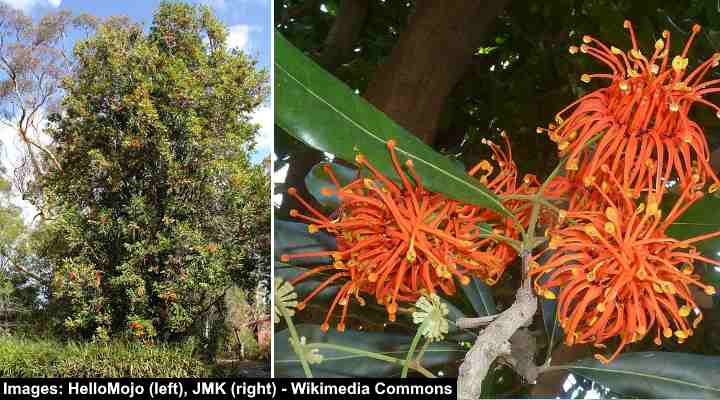
The firewheel tree is a stunning red-flowering tree native to Australia. The popular ornamental tree can be identified by its large bright red bell-shaped flowers resembling a fiery wheel. The unusual flowers have individual florets that form a round shape. The flowers bloom in shades ranging from deep scarlet to bright crimson.
The firewheel tree has glossy, dark green fern-like leaves, providing an attractive backdrop to the showy red flowers. The evergreen leaves with wavy edges and their unique bright orange-red flowers add to the tree’s overall visual appeal throughout the year.
This red-flowering tree is relatively low maintenance and can tolerate a range of soil types. Thriving in full sun and well-drained soil, the firewheel tree is a great choice for adding vibrant red shades to mixed plantings in a tropical landscape or garden.
Mature Size: 30 to 50 ft. (6 – 9 m) tall and 20 to 25 ft. (6 – 10 m) wide
USDA Hardiness Zones: 9 to 11
Sun: Full sun to partial shade
Flame Tree (Brachychiton acerifolius)
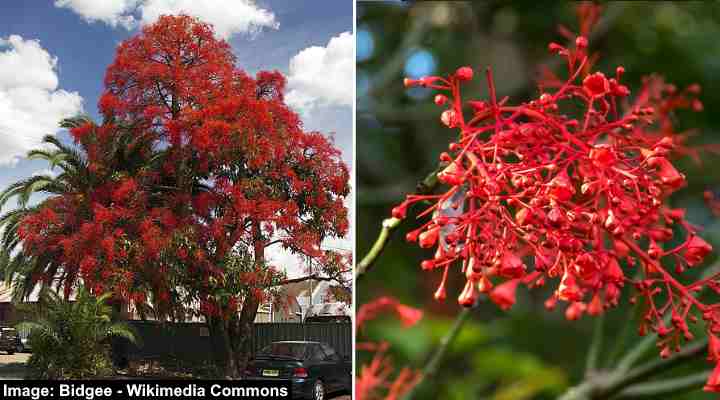
The flame tree is beautiful and produces masses of vibrant red or scarlet flower clusters. The tree’s fiery red color appears in spring and summer when its pyramidal canopy bursts into color. The bell-shaped flowers have a star-like appearance. The fragrant, nectar-rich flowers attract birds and other pollinators.
The flame tree is recognized by its large, wide, spreading canopy and abundant maple-like deciduous leaves. These large decorative leaves attach to the branches with long petioles. They are glossy green and have up to five pointed lobes. Its lush foliage provides a green backdrop to the vibrant flowers. The leaves turn yellow in the fall before dropping, revealing the tree’s unique branching structure.
Flame trees are popular ornamental trees in gardens and parks due to their striking appearance and dense foliage. These features make them ideal as shade trees or to create a focal point in a landscape.
Mature Size: 30 to 50 ft. (9 – 15 m) tall and 25 to 40 ft. (7 – 12 m) wide
USDA Hardiness Zones: 9 to 11
Sun: Full sun to partial shade
Red Flowering Camellia (Camellia japonica)
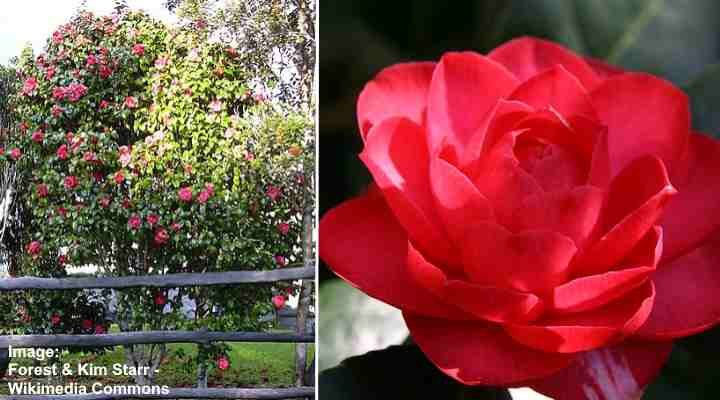
The red-flowering camellia is one of the most stunning evergreen trees with showy, vibrant red flowers. Camellia flowers are recognized by their eye-catching rose-like or peony-like blooms and symmetrical form. The fabulous red flowers bloom in late winter or early spring, adding color to the landscape when most other plants are dormant.
In addition to the stunning red peony flowers, the evergreen tree has lush, glossy green leaves providing an attractive backdrop to the flowers. Red-flowering camellias are versatile trees and shrubs with tremendous visual appeal.
Here are some varieties of red-flowering camellia that thrive in full sun to deep shade:
Camellia japonica ‘Kramer’s Supreme’: The tree’s stunning red flowers are peony-type blossoms that bloom profusely in late winter through spring.
Camellia japonica ‘Australis’: The camellia’s red flowers are rose-red and a collection of wavy, ruffled petals. The flowers bloom for several months, starting from late winter.
Camellia japonica ‘Bob Hope’: The deep red semi-double blossoms have eye-catching yellow stamens that burst into color in spring.
Camellia japonica ‘Lady Campbell’: These eye-catching bright red blossoms are rose-form flowers and contrast nicely with the glossy dark green leaves.
Mature Size: 6 to 12 ft. (1.8 – 3.6 m) tall and 6 to 10 ft. (1.8 to 3 m) wide
USDA Hardiness Zones: 7 to 9
Sun: Partial shade to deep shade
Discover many other types of flowering trees in a variety of colors.
Related articles:
